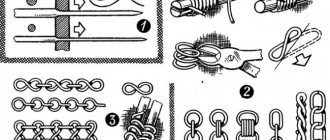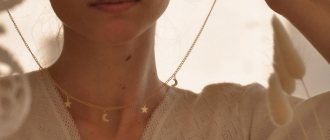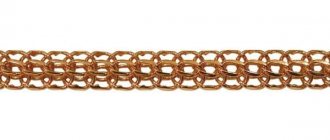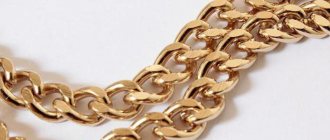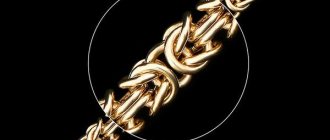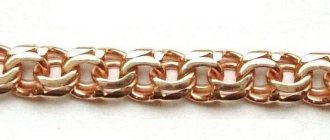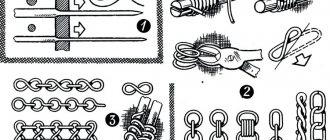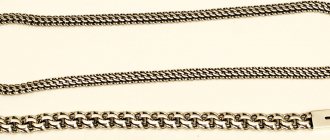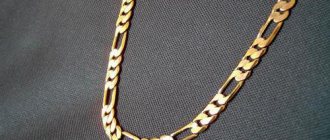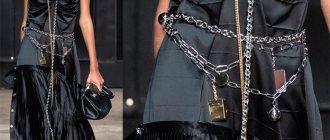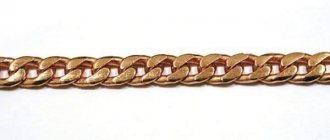A chain is the most versatile and functional product, which, thanks to the skill of specialists, has become a full-fledged piece of jewelry. It is worn as an independent accessory, complemented with a pendant, a body icon or a cross.
Now jewelry manufacturers offer us a huge number of chains: short and elongated, wide and narrow, classic and decorative, men's and women's, gold and silver, not to mention dozens of different types of weaving. How to choose a chain that is right for you? We invite you to figure this out together.
Chain weaving technologies
Chains are made in several ways - by hand, machine knitting or stamping.
Machine weaving is an automated technology using special equipment. The use of machines allows you to create jewelry with links up to 0.2 mm thick.
Despite the latest technologies, some types of weaving can only be done by hand. And here you can’t do without specialists—chain tyers. The minimum weight of a hand-woven chain is about 6 grams, and its quality largely depends on the skill of the jeweler.
This is really painstaking and time-consuming work. First you need to stretch the gold or silver wire, wind it on the prepared base and cut the resulting spiral into rings of the same size. The chain maker manually fastens the links using pliers, “linking” the pattern, which involves the type of weaving. To prevent the rings from falling apart, all the links are soldered. The resulting chain is clamped between special shafts so that the links become flat.
Stamped chains are made from ready-made links - stamps. At the same time, they are not soldered together, but threaded into each other. As a rule, such jewelry is less durable, easily twisted and deformed.
Maintenance and repair
The rules of care, frequency of use and maintainability of the jewelry depend on exactly how the chain is made. Hollow jewelry is the most fragile and almost impossible to repair: it must be taken off at night and worn irregularly, only on special occasions. A cast chain is less capricious and suitable for everyday wear.
It is better to clean “Rose” with special liquid products for jewelry. Folk remedies like raw onion powder or toothpaste will not work: due to the ornate structure of the links, it will be difficult to remove traces of such cleaning. If jewelry cosmetics are not on sale, it is better to contact a workshop.
Video
Solid or hollow: what's the difference?
All chains, regardless of the type of weaving, are divided into solid and hollow.
A distinctive feature of hollow chains is the combination of volume and lightness. The wire from which the decoration is woven is hollow inside, so despite the external thickness of the links, hollow chains have little weight. Most often they are made using complex decorative types of weaving and look quite solid. The advantage of such chains is their affordable price, which is determined by the weight of the product.
Solid chains are much heavier than hollow ones, which affects the cost of the jewelry. However, they are very comfortable for everyday wear, resistant to deformation and external influences and therefore durable. If the links are damaged, a specialist can easily solder the product and restore its original appearance.
Chain with weaving "Rose"
Chains made of precious metals are very popular among men and women.
Such jewelry can be worn on the wrist or on the neck, and their bright and original appearance will complement the image of a confident and stylish person. At the same time, in the process of creating chains, a variety of types of weaving can be used, which largely determine the appearance of the product. Our Jewelry Workshop offers you the opportunity to make custom-made explosive chains using “Rose” weaving. Such products have a truly bright and attractive appearance, and will also look great on your body. You can verify this now by looking at the photographs presented on our website.
Types of chain weaving
There are three basic technologies for knitting chains: “Anchor”, “Pantsirnaya” and “Bismarck”. Over time, they received so many variations that today there are more than 50 types of weaving: from the simplest to the most intricate with links of a complex configuration. Each weave has a special name and can be made in either gold or silver.
It’s easy to guess that “Anchor” weaving got its name due to its resemblance to the weaving of a real anchor chain. It is simple and uncomplicated. In the classic version of weaving, each link has an oval shape.
Links can consist of either one or two “rings”. Therefore, the “Double Anchor” technology is also distinguished.
An "anchor" weave with round shaped links is known as "Rollo". At one time, this type of knitting became popular thanks to the fashion house Chopard, so it has a second name - “Chopard”.
The Garibaldi weave is very similar to Rollo. The links of these chains have a round forked shape. It is believed that the knitting was named in honor of the spouses Giuseppe and Anita Garibaldi - folk heroes of the liberation movement of Italy, who were very friendly and shared each other’s views.
Fantasy types of “Anchor” weaving also include “Aurora” and “Hawaiian”.
“Shell” technology has become the basis for creating various types of decorative weaving. Its distinctive feature is that the flat links, polished on both sides, are not attached perpendicular to each other, but as if in the same plane. The technology, characterized by its high strength, got its name due to its resemblance to chain mail links.
Weaving can be single, double or triple, depending on the number of rings connected. A “shell” knit with diamond-shaped links is called “Diamond” (it can also be double or triple).
“Nonna” is one of the most elegant varieties of armor weaving. Thanks to the diamond edge applied on both sides, such chains shine more in the light. Despite the external sophistication, these jewelry are very durable. Oddly enough, the name of the weave has nothing to do with the woman's name. Nonna is short for the Italian maglia della nonna, which means "grandmother's weave."
An equally spectacular variety of armor knitting is “Figaro”, named after the famous comedy hero Beaumarchais, who was distinguished by his changeable temperament. Just like Figaro, weaving is characterized by “inconstancy” - links of different shapes, short and long, alternate in the chain. The most common combinations are from 1:1 to 1:5. Figaro chains gained popularity thanks to the jewelry house Cartier, and gradually became known as “Cartier”.
Often chains get their names due to the special shape of the links. Thus, the “rings” resembling hearts gave the name to the romantic and delicate weaving “Love”. Thanks to the links twisted into a spiral, the “Snail” weave appeared (it is also called “Paperclip” for the similarity of the “rings” with the stationery of the same name), and the divisions, similar to a beautiful flower, gave the name to the “Rose” chain.
A smooth, snake-like jewelry cord with tightly fitting links is known as a “Snake.” This weaving is comfortable for everyday wear, so it is often used not only in the manufacture of chains, but also bracelets for pendants and charms.
The most popular twisted weaves are the rope-like “Korda” and the “Singapore” shimmering in the sun. Such chains are usually worn by women. These decorations are elegant and at the same time reliable in use.
But “Bismarck” is considered a truly masculine type of weaving in Russia. Named, according to one version, in honor of the first Chancellor of the German Empire, Otto von Bismarck, he is also known as the “Kaiser” or “Cardinal”. This weaving is one of the most complex and is therefore often done by hand. Fantasy knitting consists of links, which in turn consist of several multidirectional “rings”. The weave can be double, triple or quadruple, making it one of the strongest. Due to its thickness and volume, one of the varieties of “Bismarck” was called “Python”.
An undeniable trend is the so-called fantasy chains. These decorations are distinguished by unusual types of weaving, a combination of different shades of metals, multi-layering and the inclusion of decorative “links”. Fantasy chains are more reminiscent of a necklace or beads and are a completely independent decoration that can be worn without a pendant.
Advantages
A precious metal chain created using the “Rose” weaving method has several advantages, among which we should highlight:
- Versatility. It is equally suitable for creating both women's and men's jewelry. In addition, it can also be used in the manufacture of products intended for children;
- Reliable to use. The links of the chain are connected to each other in three places at the same time, so you can be sure that it will not break even under strong impact.
Which weave to choose?
Of course, first of all it is a matter of taste. However, some types of chains are traditionally classified as women's, men's or universal. Thus, the massive and solid “Bismarck” is most often preferred by representatives of the stronger sex, and the graceful “Nonna”, “Singapore”, “Rose”, “Love” and a number of other varieties are considered truly feminine. A typical unisex weaving option is “Anchor”.
For children, the most optimal are densely knitted chains, for example, “Snake”, as well as jewelry cords made of rubber or leather.
Choosing the chain length
One of the important criteria when choosing a chain is its length. As a rule, the size range consists of models from 40 to 70 cm.
- 40 cm - the chain is worn close to the neck
- 50 cm - the chain is worn at the level of the upper part of the neckline
- 60 cm - the chain is worn at the level of the middle part of the neckline
- 70 cm - the chain is worn at the level of the lower part of the neckline
It is believed that it is better for women to choose chains up to 50 cm, and for men - longer. Still, there are exceptions to every rule, and when purchasing jewelry, you must try it on.
Types of chain locks
When purchasing a jewelry chain, pay attention to its lock. Firstly, it must be of high quality, since the safety of the jewelry depends on this “minor” detail. And secondly, the lock should be comfortable so that you can fasten and unfasten it yourself, easily putting any pendants on the chain.
As a rule, the type of lock is selected by the jeweler depending on the weight and type of weaving of the item. More massive chains have reliable carabiners, while elegant, thin models are more suitable for a spring lock. Most often, both types of fasteners allow you to easily put pendants with different eye thicknesses on a chain, so they are approximately equivalent to each other in terms of convenience and reliability.
Peculiarities
The name of the jewelry weave is explained simply: it was nicknamed a rose because of its resemblance to the flower of the same name. The technique is used to create products from different metals: silver, platinum, but most often gold. Models made of rose or red gold are in greatest demand.
Weaving is interesting because a chain made from it looks like an independent decoration. It can be worn without pendants or other decor. “Rose” draws attention to the décolleté area and effectively emphasizes the neckline of a dress or blouse.
The weaving is of the cord type. Its characteristic feature is the joining of rings in several places at once. Thanks to this, the product becomes durable, acquires the beauty of openwork, elegance, lightness and sophistication.
Interestingly, there is a similar chain mail weave called "Moorish rose". The technique has survived to this day: it is used by role players to create ancient military ammunition.
Combination of chain with bracelet and pendant
Many of us wear a chain all the time, so we don’t perceive it as decoration. However, we should not forget that this is an accessory that, like any piece of jewelry, requires special combination rules.
The pendant should match the chain in size, weight (about twice as light) and metal color. Thus, a large pendant or cross on a thin chain will look ridiculous, and at the same time, a pendant that is too small will not fit on a massive item.
Be sure to check that the ear of the pendant fits freely through the lock.
In addition to ordinary chains, there are also chain bracelets that are often worn by both women and men. Ideally, the types of weaving of both products should match, but this does not happen often - jewelry can be given as a gift, purchased in different places, or several years apart. Therefore, it is enough that the bracelet and chain match each other in thickness and metal. For example, the “Nonna” chain will look good with a “Rhombus” or “Love” weave bracelet, and the “Bismarck” chain will look good with a wide “Armor” knit.
In any case, if you doubt the compatibility of two decorations, it is better to leave one. As the incomparable Coco Chanel said, “When choosing accessories, take off the last thing you put on.”
What to wear with
The “Rose” weave chain is a stylish piece of jewelry that can be worn every day, combined with an office dress code or casual clothing. It suits both young girls and representatives of the older generation equally. But more often “Rose” is chosen by older ladies.
An openwork chain is not combined with a pendant: it is a self-sufficient decoration, and due to the massive pendant, the links may become deformed. It is combined with a bracelet made using the same technique. A pair of small earrings with a laconic design is allowed.
